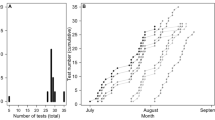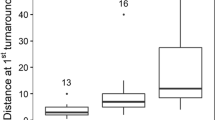Abstract
Consistent individual behavioral differences across ecological contexts are a recognized feature of animal populations. These differences can be expressed in two ways: context-specifically or context-generally. The former is characterized by consistent responses in one context (i.e. repeatability), whereas the latter by consistency that spans contexts (i.e. behavioral syndromes). The proximate causes of behavioral consistency remain unclear, yet there is evidence that physiology may couple the expression of some behavioral traits in unrelated contexts. We therefore explored the correlation between bold behavior of female sand fiddler crabs (Uca pugilator) and the condition of the hepatopancreas, an organ vital to crustacean metabolism and reproduction. We did this by taking replicate measurements of two risk-taking behaviors per individual in the contexts of predator avoidance and environment exploration, and examining correlations within and between these observations. We then determined the relationship of behavior with hepatopancreas mass and lipid content. Individual crabs responded consistently within each context. However, across-context correlations were absent, indicating that boldness is isolated, at least in the selected scenarios. Additionally, anti-predator and exploratory behaviors were significantly influenced by size but not linked to hepatopancreas physiology. Our results show that context-specific trait expression may occur in the absence of a physiological correlate.



Similar content being viewed by others
References
Bell AM, Hankison SJ, Laskowski SL (2009) The repeatability of behavior: a meta-analysis. Anim Behav 77:771–783
Bergmüller R, Taborsky M (2010) Animal personality due to social niche specialization. Trends Ecol Evol 25:504–511
Bildstein KL, McDowell SG, Brisbin IL (1989) Consequences of sexual dimorphism in sand fiddler crabs, Uca pugilator: differential vulnerability to avian predation. Anim Behav 37:133–139
Biro PA, Beckmann D, Stamps JA (2010) Small within-day increases in temperature affects boldness and alters personality in coral reef fish. Proc R Soc Lond B 277:71–77
Boyer N, Réale D, Marmet J, Pisanu B, Chapuis JL (2010) Personality, space use and tick load in an introduced population of Siberian chipmunks Tamias sibiricus. J Anim Ecol 79:538–547
Brown C, Jones F, Braithwaite VA (2005) In situ examination of boldness–shyness traits in the tropical poeciliid, Brachyraphis episcopi. Anim Behav 70:1003–1009
Christy JH (1978) Adaptive significance of reproductive cycles in the fiddler crab Uca pugilator: a hypothesis. Science 199:453–455
Christy JH (1983) Female choice in the resource-defense mating system of the sand fiddler crab, Uca pugilator. Behav Ecol Sociobiol 12:169–180
Christy JH, Morgan SG (1998) Estuarine immigration by crab postlarvae: mechanisms, reliability and adaptive significance. Mar Ecol Prog Ser 174:51–65
Colby DR, Fonseca MS (1984) Population dynamics, spatial dispersion and somatic growth of the sand fiddler crab Uca pugilator. Mar Ecol Prog Ser 16:269–279
Coleman K, Wilson DS (1998) Shyness and boldness in pumpkinseed sunfish: individual differences are context-specific. Anim Behav 56:927–936
Crane J (1975) Fiddler crabs of the world. Ocypodidae: genus Uca. Princeton University Press, New Jersey
de Azevedo CS, Young RJ (2006) Shyness and boldness in greater rheas Rhea americana: the effects of anti-predator training on the personality of the birds. Rev Bras Zool 23:202–210
Dingemanse NJ, Réale D (2005) Natural selection and animal personality. Behaviour 142:1159–1184
Dingemanse NJ, Kazem AJN, Réale D, Wright J (2009) Behavioral reaction norms: animal personality meets individual plasticity. Trends Ecol Evol 25:81–89
Ens BJ, Klaassen M, Zwarts L (1993) Flocking and feeding in the fiddler crab (Uca tangeri): prey availability as risk-taking behavior. Neth J Sea Res 31:477–494
Garamszegi LZ, Rosivall B, Rettenbacher S, Markó G, Zsebök S, Szöllősi E, Eens M, Potti J, Török J (2012) Corticosterone, avoidance of novelty, risk-taking and aggression in a wild bird: no evidence for pleiotropic effects. Ethology 118:1–15
Gibson R, Barker PL (1979) The decapod hepatopancreas. Oceanogr Mar Biol 17:285–346
Hara A, Radin NS (1978) Lipid extraction of tissues with a low toxicity-solvent. Anal Biochem 90:420–426
Hugie DM (2004) A waiting game between the black-bellied plover and its fiddler crab prey. Anim Behav 67:823–831
Jennions MD, Backwell PRY, Murai M, Christy JH (2003) Hiding behavior in fiddler crabs: how long should prey hide in response to a potential predator? Anim Behav 66:251–257
Kennish R (1996) Diet composition influences the fitness of the herbivorous crab Grapsus albolineatus. Oecologia 105:22–29
Koolhaas JM, Korte SM, De Boer SF, Van Der Vegt BJ, Van Reenen CG, Hopster H, De Jong IC, Ruis MAW, Blokhuis HJ (1999) Coping styles in animals: current status in behavior and stress-physiology. Nuerosci Biobehav Rev 23:925–935
Korpela K, Sundell J, Ylönen H (2011) Does personality in small rodents vary depending on population density? Oecologia 165:67–77
Kyomo J (1988) Analysis of the relationship between gonads and hepatopancreas in males and females of the crab Sesarma intermedia, with reference to resource use and reproduction. Mar Biol 97:87–93
Layne J, Land M, Zeil J (1997) Fiddler crabs use the visual horizon to distinguish predators from conspecifics: a review of the evidence. J Mar Biol Assoc UK 77:43–54
Mettler AE, Shivik JA (2006) Dominance and neophobia in coyote (Canis latrans) breeding pairs. Appl Anim Behav Sci 102:85–94
Plaistow SJ, Troussard JP, Cézilly F (2001) The effect of the acanthocephalan parasite Pomphorhynchus leavis on the lipid and glycogen content of its intermediate host Gammarus pulex. Int J Parasitol 31:346–351
Quackenbush LS, Keeley LL (1988) Regulation of vitellogenesis in the fiddler crab, Uca pugilator. Biol Bull 175:321–331
Réale D, Gallant BY, Leblanc M, Festa-Bianchet M (2000) Consistency of temperament in bighorn ewes and correlates with behavior and life history. Anim Behav 60:589–597
Reaney LT, Backwell PRY (2007) Risk-taking behavior predicts aggression and mating success in a fiddler crab. Behav Ecol 18:521–525
Rehage JS, Sih A (2004) Dispersal behavior, boldness, and the link to invasiveness: a comparison of four Gambusia species. Biol Invasions 6:379–391
Reinsel KA, Rittschof D (1995) Environmental regulation of foraging in the sand fiddler crab Uca pugilator. J Exp Mar Biol Ecol 187:269–287
Sih A, Bell AM, Johnson JC (2004a) Behavioral syndromes: an ecological and evolutionary overview. Trends Ecol Evol 19:372–378
Sih A, Bell AM, Johnson JC, Ziemba RE (2004b) Behavioral syndromes: an integrative overview. Q Rev Biol 79:241–277
Sinn DL, Moltschaniwskyj NA (2005) Personality traits in dumpling squid (Euprymna tasmanica): context-specific traits and their correlation with biological characteristics. J Comp Psychol 119:99–110
Skov MW, Hartnoll RG, Ruwa RK, Shunula JK, Vannini M, Cannicci S (2005) Marching to a different drummer: crabs synchronize reproduction to a 14-month lunar-tidal cycle. Ecology 86:1164–1171
Speck U, Urich K (1969) Der Abbau korpereigener Substanzen in dem Flusskrebs Orconectes limosus wärhend des Hungerns. Z Vergl Physiol 63:410–414
Webster MM, Ward AJ, Hart PJB (2007) Boldness is influenced by social context in threespine sticklebacks (Gasterosteus aculeatus). Behaviour 144:351–371
Wilson ADM, Godin JGJ (2009) Boldness and behavioral syndromes in bluegill sunfish, Lepomis macrochirus. Behav Ecol 20:231–237
Wilson ADM, Godin JGJ, Ward AJW (2010) Boldness and reproductive fitness correlates in Eastern mosquitofish, Gambusia holbrooki. Ethology 116:96–104
Wolf M, Weissing FJ (2010) An explanatory framework for adaptive personality differences. Philo Trans R Soc Lond B 365:3959–3968
Wolf M, van Doorn GS, Leimar O, Weissing FJ (2007) Life-history trade-offs favor the evolution of animal personalities. Nature 447:581–584
Yamaguchi T (2001) Seasonal change of the hepatopancreas index in the males of the fiddler crab, Uca lactea. Crustaceana 74:627–634
Yamaguchi T (2003) Seasonal changes in the energy content of females of the fiddler crab, Uca Lactea, especially during the reproductive period. Crustaceana 76:1371–1397
Yang EJ, Phelps SM, Crews D, Wilczynski W (2001) The effects of social experience on aggressive behavior in the green anole lizard (Anolis carolinensis). Ethology 107:777–793
Zupanc GKH (2010) Behavioral neurobiology: an integrative approach. Oxford University Press, New York
Acknowledgments
Our work was funded by the University of South Carolina. We thank M. Repetto for help with sample processing. Thanks also to S. Woodin, J. Dudycha, B. Toscano, and anonymous reviewers for helpful comments on earlier drafts. Finally, thanks to the Baruch Marine Research Reserve and its staff for the use of equipment and resources.
Author information
Authors and Affiliations
Corresponding author
About this article
Cite this article
Decker, R.A., Griffen, B.D. Correlating context-specific boldness and physiological condition of female sand fiddler crabs (Uca pugilator). J Ethol 30, 403–412 (2012). https://doi.org/10.1007/s10164-012-0338-9
Received:
Accepted:
Published:
Issue Date:
DOI: https://doi.org/10.1007/s10164-012-0338-9




